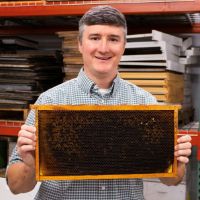Healthy and Sustainable Beekeeping
A special issue of Insects (ISSN 2075-4450). This special issue belongs to the section "Insect Societies and Sociality".
Deadline for manuscript submissions: 30 April 2024 | Viewed by 10408
Special Issue Editors
Interests: honey bee; apiculture, bee pathology; selection and breeding; resilience; health; precision beekeeping
2. Bee Research Center, Agroscope, 3097 Liebefeld, Switzerland
Interests: bees; population genetics; host-parasite interactions; behavioural ecology; invasive species
Special Issues, Collections and Topics in MDPI journals
Special Issue Information
Dear Colleagues,
The recent unsustainable colony loss rates and deterioration of honey bee health observed globally call for adequate mitigation measures. Evidence-based solutions are key to solving these issues. Thus, research plays a central role in providing fundamental and practical knowledge to design strategies needed to combat poor colony health.
With this in mind, we decided to create a new Special Issue (SI) focusing on solutions to enhance sustainable beekeeping. Via this SI, we will consider research articles and reviews of various disciplines related to the beekeeping of Apis spp. (including Apis mellifera and any of the Asian honey bees). Our primary aim is to improve bee management. Topics of particular interest include health monitoring, socio-economics, mitigation of stressors, and improvement of pest control and precision beekeeping. However, candidate authors may also submit articles related to other topics.
Prof. Dr. Dirk C. De Graaf
Dr. Alexis L. Beaurepaire
Dr. James D. Ellis
Guest Editors
Manuscript Submission Information
Manuscripts should be submitted online at www.mdpi.com by registering and logging in to this website. Once you are registered, click here to go to the submission form. Manuscripts can be submitted until the deadline. All submissions that pass pre-check are peer-reviewed. Accepted papers will be published continuously in the journal (as soon as accepted) and will be listed together on the special issue website. Research articles, review articles as well as short communications are invited. For planned papers, a title and short abstract (about 100 words) can be sent to the Editorial Office for announcement on this website.
Submitted manuscripts should not have been published previously, nor be under consideration for publication elsewhere (except conference proceedings papers). All manuscripts are thoroughly refereed through a single-blind peer-review process. A guide for authors and other relevant information for submission of manuscripts is available on the Instructions for Authors page. Insects is an international peer-reviewed open access monthly journal published by MDPI.
Please visit the Instructions for Authors page before submitting a manuscript. The Article Processing Charge (APC) for publication in this open access journal is 2600 CHF (Swiss Francs). Submitted papers should be well formatted and use good English. Authors may use MDPI's English editing service prior to publication or during author revisions.
Keywords
- beekeeping
- socio-economics
- pest control
- health monitoring
- pollinator declines








